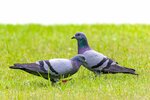

Tweetings, fellow birders! Thanks for flying in to read this column! This week we're going to look at a familiar visitor not necessarily to your backyard feeder, but rather, to your power lines. I'm referring to the friendly pigeon, an overlooked resident of both city and suburbia.
Let's dive in and have a closer look at this dandy relative of the Dodo.
The most common version of the species in New England is known as the Rock Pigeon. Their plumage typically consists of a dark blue head and breast, bluish-gray back and wings, modest dark stripes or spots across the outer portions of the feathers and a greenish-blue patch on the back of the neck, along with orange-colored feet and a short thick beak.
They are large plump birds but also strong and excellent fliers, often gathering together in large flocks for safety and warmth. While walking they always bob or move their heads forward, most likely to stabilize vision, and the bird also emits a famous "coo-coo'' sound (although I assure you that they are not crazy!).
Other species you might find here in North America are the Band-Tailed Pigeon, White-Crowned-Pigeon and Red-Billed Pigeon, although these birds are much more situated in the southern regions of the country. The common pigeon is not native to the continent, being brought over from Europe and North Africa, but quickly multiplied in their new surroundings, supplanting other local species. As all pigeons are considered game birds, they are hunted in various locations for either
food or sport.
In fact, this led to the sad extinction of the Passenger Pigeon, the last bird (named Martha) dying in a Cincinnati zoo in 1914.
Now, to be honest, as far as backyard feeders go, pigeons are not your usual visitors. Most are far too large to perch upon a hanging feeder and, oddly, it is rare, at least in my experience, to see a pigeon sitting in a tree (they tend to prefer rooftops). However, I have had a few encounters where they DID visit and, frankly, they made a mess of the whole scene! The flock devoured the pile of seeds almost instantly (as the birds are fast eaters) and this act was repeated yet again after I had refilled the platform feeding station.
Don't get me wrong: I like pigeons, but songbirds are a bit more gracious while dining! So, the question is, if this occurs, what should you do?
Well, being ground-feeders, I found a great alternative was to offer them bits of bread and crackers in another location. Just toss some handfuls of food on the ground and the birds will happily take to the new setting. After a spell they forgot about my previous feeding stations and I was able to reclaim the songbirds I was initially trying to attract.
So please, try not to just shoo the pigeons away. Remember, they have chicks to feed and "bills" to pay, too! (get it? Bills to pay?).
This was the suburbs, but in major cities (such as Boston) you will often find large flocks in all locales, especially within parks. Being used to humans, the birds are often fearless, and I admit, can be a little bit of a nuisance at times (but then again, aren't we all?). If you do decide to feed them while resting on a park bench, popcorn or peanuts are always a nice treat. Just don't be surprised if they gather around you in massive numbers, as those who feed, lead.
However, the birds do make great companions, as they are rather intelligent, and may even come to recognize you by both sight and sound. Pigeons are often raised on city rooftops in large cages, and many have even come to be seen as both family and friend.
The point is, they are a beautiful bird, a classic American fixture, and will hopefully be with us for years to come. Appreciate them, and don't take them for granted, or they else they might fly off into the distant sunset…
And yes, I shall end this article with a joke:
Q: What do you call a bird sitting in a wooden chair?
A: A "stool pigeon!"
Come on … It wasn't that bad!